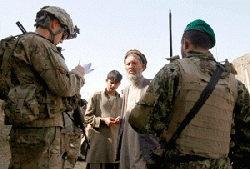The death penalty may await the U.S. staff sergeant who slaughtered 16 civilians – mostly women and children – in Afghanistan. The soldier’s name has yet to be released, but new details have surfaced alleging what may have led to this tragedy.

|
| U.S.-Afghan Army soldiers interrogate residents during a patrol in Sangum Ghaki Valley in eastern Afghanistan March 14, 2012. REUTERS |
The man behind the Kandahar massacre is thought to be an 11-year veteran who served three tours in Iraq and was trained as a sniper. The soldier reportedly suffered a traumatic brain injury in a vehicle blast accident while on Iraq duty. It’s also reported that he faced marital problems and difficulties with reintegrating into normal life.
But according to medics he had managed ‘to overcome the issues’. Instead of invalidating him out of the service – he was allowed to continue and was later deployed to Afghanistan.
Medical experts say the tragedy may have been avoided if U.S. soldiers’ mental health was better monitored and that the man had probably displayed signs of growing tension before the shooting rampage:
“This could have been signaled by erratic and unusual behavior, insomnia, talking nonsensically or incoherently, making threatening statements and using drugs,” Dr Jeffrey Lieberman, Director of the New York State Psychiatric Institute told ABC News.
If the suspected mental breakdown is confirmed, the U.S. military may fall under heavy criticism.
While experts agree the current system for detecting mental breakdown in personnel is inadequate, U.S. officials seem to be simply writing-off the tragedy as acceptable collateral damage. U.S. Secretary of Defense Leon Panetta, for instance, admits that incidents as shocking as the Kandahar massacre may take place in future.
“War is hell,” he said. “This is not the first of those events, and probably won’t be the last.”
If Panetta is right, and the system does not need to be changed – it is only a matter of time before another tragic loss of innocent life makes the headlines.
Patrick Martin, an editor at the World Socialist website, compares the killing of Afghan civilians to the notorious My Lai Massacre in Vietnam. Both incidents “expressed the hostility that is building up between the invading force and the local population,” he told RT.
“And they express the growing demoralization of the troops themselves,” Martin said. “After all, to carry out orders, like the orders that were carried out nearly 44 years ago in My Lai, one has to be a bit mad, right?”
— RT






Leave a Reply